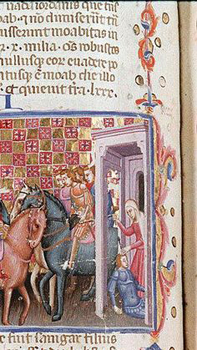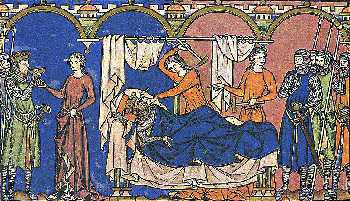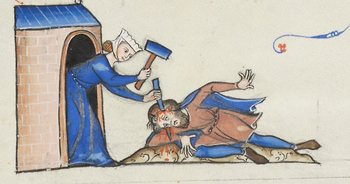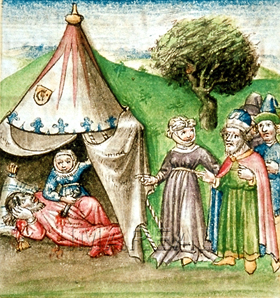"She Shattered His Temple"
Ten Suggestions for Reading "Texts of Terror"
by Dan Clendenin
For Sunday November 16, 2014
Lectionary Readings ( Revised Common Lectionary , Year A)
Judges 4:1–7 or Zephaniah 1:7, 12–18
Psalm 123 or Psalm 90:1–8, (9–11), 12
1 Thessalonians 5:1–11
Matthew 25:14–30
Judges 4 for this week is one of the most barbaric stories in the Bible. A housewife named Jael defeats a king named Jabin by pounding a tent peg through the temple of his commander Sisera. The story concludes with a war poem that taunts Sisera's mother and celebrates Jael's violence: "Most blessed of women be Jael. / She struck Sisera, she crushed his head, / she shattered and pierced his temple."
A few pages later there's an even more repulsive story — the gang-rape, murder, and dismemberment of a nameless concubine (Judges 19).
There's lots of hand-wringing these days about Islamic violence, especially the beheading videos by ISIL, but religious violence is embedded in our Christian scriptures. The story about Jael isn't an isolated incident.
God commanded Saul to "attack the Amalekites and totally destroy everything that belongs to them. Do not spare them; put to death men and women, children and infants, cattle and sheep, camels and donkeys" (1 Samuel 15).

|
|
From a Biblia Sacra. Codex Vindobonensis Palatinus 1191.
|
David beheaded Goliath, then "took the Philistine's head and brought it to Jerusalem" (1 Samuel 17).
In Deuteronomy 7:2 and 20:16–17 we read: "You must destroy them totally. Make no treaty with them, and show them no mercy… Do not leave alive anything that breathes — completely destroy them."
The priest Phinehas was praised for his zeal when he slaughtered an Israelite and a Midianite woman with a single thrust of his spear (Numbers 25). Today the Eastern Orthodox churches celebrate Phinehas as a saint every year on September 2.
There are many more examples. In his book Laying Down the Sword; Why We Can't Ignore The Bible's Violent Verses (2011), Philip Jenkins, professor at Penn State, has a table that lists the nineteen "most disturbing conquest texts." Back in 1984, Phyllis Trible coined a phrase for the title of her book that ever since then has served as a proxy for violent verses like these — she called them "texts of terror."
Today we would call these texts of terror genocide, crimes against humanity or war crimes. Yes, the Bible is a bloody book.
These stories aren't a new problem. Down through the centuries readers have developed interpretive strategies to try to understand these texts. Here are ten of those strategies. Most of them contain elements of truth, and I find them partly helpful. But none of them is fully satisfying. At the end of the day, the texts of terror remain part of our Christian scriptures.
1. Many believers ignore or avoid these texts. They're embarrassing, and have little relevance for our lives. We naturally gravitate toward passages like Jesus's Beatitudes. Jenkins observes how even a three-year cycle of weekly Bible readings like the Revised Common Lectionary omits most of the texts of terror. But ignorance is not bliss. We ignore the texts of terror at our peril, because many believers have used them to justify their own violence. We need to face up to them.

|
|
From the Maciejowski Bible, c. 1250.
|
2. Christians often claim that all Scripture is equally important or equally inspired, but in practice most of us invoke a "canon within the canon" — consciously or unconsciously, we privilege some parts of the Bible over others. And that's the way it should be. John 3:16 is more important than Judges 4. Texts of terror remind us that we don't, we can't, and we shouldn't read all Scripture in the same way. In his book How the Bible Became Holy (2014), Michael Satlow shows why we must be careful when we claim that the Bible is holy or inspired.
3. A religion is more than its texts, and so many readers emphasize God's perfect character over a finite human text (however sacred). An early bishop named Marcion (c. 85–160) rejected the violent deity of the Old Testament in favor of the heavenly father of Jesus. A contemporary example of a similar outlook is Robert Wright's book The Evolution of God (2009). Wright argues that religion has evolved from the barbaric polytheistic deities of the Stone Age to the benevolent monotheistic god of the three Abrahamic faiths.
4. It's obvious that the crude stories of sacred violence reflect the savagery of their ancient cultures. The violence is no worse than what every people and religion did back then — or today. When Jonah preached to the Assyrian Ninevites, for example, he was going to a people that "scorched its enemies alive to decorate its walls and pyramids with their skin" (Ellul). Every text reflects its own time and place.
5. Sometimes these violent verses are historical descriptions of tragic events, not moral prescriptions for us to follow today. This is certainly true of the gang rape in Judges 19. It reads like a story that's intended to shock and shame Israel for its deeply degraded culture where "every person did what was right in his own eyes." The violent acts of minority extremists are rare exceptions, and don't represent the core values of a religion's mainstream majority.

|
|
Biblia Porta, 13th century France.
|
6. Beginning with scholars like Origen (185–254), and lasting for a thousand years, many Christians employed allegorical interpretations that de-emphasized the literal meaning. Many people today read the Bible for spiritual or moral meanings. Many Muslims similarly insist that the true jihad or holy war is waged in the inner soul rather than against external enemies.
7. Others appeal to God's wisdom that's incomprehensible and inscrutable to us mere mortals. Who are we to question the Almighty? Job 38–41, for example, is a withering interrogation of over seventy questions that God puts to Job. Any number of Biblical texts echo Isaiah 55:8, "For my thoughts are not your thoughts, neither are your ways my ways," declares the Lord.
8. Some readers say that the Canaanites were evil and deserved their fate, but this is a dangerously self-justifying strategy.
9. We rightly read these highly stylized stories with some historical scepticism and not as simple eyewitness reportage. These stories were written about five hundred years after the purported events, and they enjoy little to no archaeological support. In his book The Kings and Their Gods (2008), for example, Daniel Berrigan reads 1–2 Kings as self-serving imperial records that portray Israel's kings as they saw themselves and wanted others to see them — God is with us and against our enemies. He blesses us with their booty. No war crime is too heinous as a means to these delusional ends.
10. Jenkins urges us to dig deeper for a core message: "The imagined war against outside peoples and customs symbolized a rejection of any and all things that distract or separate a people or an individual from God" (224). For Jenkins, that "core truth" is the fundamental implication of radical monotheism — the absolute God deserves unconditional obedience from his chosen people.
Whether these strategies of selective reading are helpful or not, Jenkins arrives at a surprising conclusion — they aren't necessary. Instead of avoiding the violent verses or explaining them away, we should read, absorb, comprehend, and even preach these texts of terror.

|
|
Illustrated Bible from 1448.
|
And in a line of argument that he mentions but doesn't develop, he quotes Rene Girard of Stanford whose important work on religious violence has argued that the Bible is the first text to present sacred violence from the perspective of the victim, and thus, paradoxically,"it is for biblical reasons that we criticize the Bible" (7, 240). In 1–2 Kings, says Berrigan, the Bible is thus "deconstructing" itself; "the medium itself is the message."
It's not fully satisfying, but that might be about as good as it gets when it comes to texts of terror.
For further reflection:
Consider the Westminster Confession (1649): "Not all things in Scripture are equally clear, or equally clear to all people. But those things that are necessary to be known, believed and observed, for salvation, are so clearly propounded and opened in some place of Scripture or other that not only the learned but the unlearned, in a due use of the ordinary means, may attain a sufficient understanding of them."
Image credits: (1) Pinimg.com ; (2) MedievalTymes.com ; (3) Tumblr.com ; and (4) Institut für Realienkunde, Universität Salzburg .





